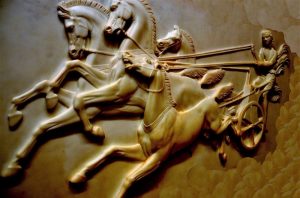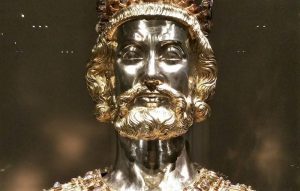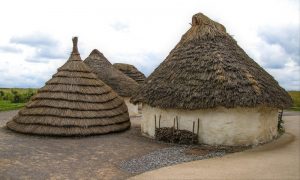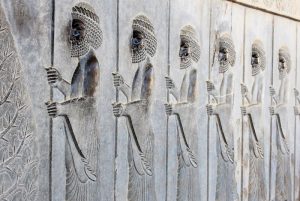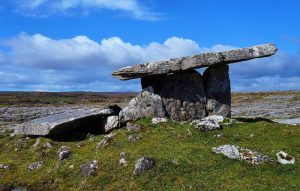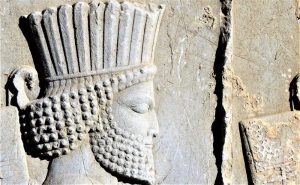Spanish Empire
The Spanish Empire is a name that has been designated to all the territories that were conquered and ruled by Spain as a result of the exploration and colonial expansion that had its beginnings in the fifteenth century. This expansion made Spain the first transcontinental superpower during the 16th and 17th centuries and helped shape most of the modern world. Built on military power and naval ingenuity and maintained by trade and mining of precious metals such as gold and silver, this period is appropriately known as Spain's Golden Age.
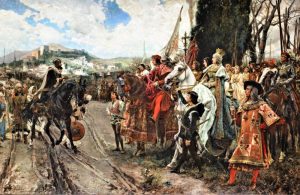
- Establishment date: 17/04/1492
- When it ended: 1975
- Capital city: Madrid, Valladolid
- Religion: Catholic religion
- Government: Monarchy
What was the Spanish Empire?
Spanish Empire is the set of territories governed by Spain's dynasties during the 16th and 19th centuries, which began with Christopher Columbus' travels to new lands and which had important repercussions in Europe, mainly in the conquered territories.
- Summary
- Origin of the Spanish Empire
- Stages
- Apogee
- Crisis and fall of the Spanish Empire
- Causes
- Consequences
- Characteristics
- Location
- Extension
- Political and social organization of the Spanish Empire
- Economy
- Cultural manifestations of the Spanish Empire
- Customs and traditions
- Religion
- Food
- Contributions
- Importance of Spanish Empire
- Colonies of the Spanish Empire
Summary
The Spanish Empire in America was born as a result of Christopher Columbus’ travels and his discovery of a New World for the Castile Crown. The kings understood the importance of these territories and promoted new journeys along the coast, the interior of the new continent and the islands of the Pacific Ocean.
They needed a great political organization as the territories were extensive and the Council of the Indies was created which advised the king regarding the government and justice of the overseas territories. In America, the most important institutions of government were the viceroyalties, the audiences and the councils.
Origin of the Spanish Empire
The process that led to the formation of the Spanish Empire has its origin in the Reconquest, the crusades undertaken by Christian kingdoms in the north of the Iberian Peninsula against the Muslims who had invaded from North Africa. It was the marriage of Isabel I of Castile and Ferdinand V of Aragon in 1469 and the resulting union of their separate Iberian kingdoms that marked the beginning of Spain’s overseas empire. Several main reasons may explain Spain’s expansion abroad.
Stages
The Spanish Empire went through a series of situations until it managed to establish itself and gain strength, these stages were the following:
- The beginnings of the Empire: when the union of the two kingdoms takes place after the marriage of the Catholic kings. They supported Christopher Columbus to sail the seas.
- The Golden Age: the arts and sciences There was much gold in Spain from the Indies and the empire was ruled from Seville. The Hapsburg dynasty spent the wealth and left Spain bankrupt.
- From Pavia Battle to Augsburg Peace: The Peace of Barcelona was signed between Charles I and the Pope in 1529, recognizing Charles as King of Lombardy and Spain as defender of the Catholic cause. Spain continued to expand throughout the New World and laws were made to protect the natives of the American colonies, although they were rarely put into practice.
- From St. Quentin to Lepanto: Marriage with Maria Tudor made England and Spain allies, but Spain could not have peace. Henry II fought France and Spain because he saw its power and territorial extension.
- The Empire of the last Spanish Hapsburgs: The Battle of Rocroi is marked as the end of Spanish dominion. Portugal declares independence and Spain also loses the Netherlands. France became the most important power.
- The Bourbon Empire: European powers decide the future of Spain and the balance of power.
Apogee
It reached its peak between the 16th century and the first half of the 17th century thanks to the discovery of America in 1492. Charles I inherited the Castilian Crown in the Iberian Peninsula and all the territories in America, the possessions of the Crown of Aragon; the lands of the Habsburgs in Austria becoming the emperor of the Sacred Empire; in addition to the Netherlands; it conquered Tunisia and was at war with France for the region of Lombardy.
Crisis and fall of the Spanish Empire
During the 16th century, the first symptoms of Spain’s decadence occurred as a result of the insurrection in the Netherlands, the failure of Spanish policy in the Mediterranean and the increase in incursions by pirates.
Causes
The main causes were the Bourbon reforms, mainly the commercial laws that allowed to decrease the Spanish possessions that had achieved through monopoly. These measures achieved free trade with Spain and between the same colonies.
There were also losses in the colonial market because the merchants of Cadiz blocked the expansion of shipbuilding and the colony focused its economy on agriculture and livestock. The French invasion of Spain, the battle of Cartagena de India’s, the confrontation of Spain and Portugal and the seven-year War also influenced the fall.
Finally, the creation of independence movements within the American governments, the discontent of the Creoles, the creation of the mestizo race, the growth of the economic autonomy of the American colonies and the independence ideas that emerged with the French revolution.
Consequences
The main consequences were the economic problems because the war expenses had to be paid. Land was mortgaged and the economic future of the kingdom was compromised to finally declare bankruptcy.
Characteristics
The main characteristics of the Spanish Empire were:
- It began with the discovery of Christopher Columbus to America.
- They had a series of institutions that allowed them to exercise control more easily.
- It was created under the reign of Charles I.
- The Council of the Indies was the most important organ of the entire Spanish Empire.
- They practiced barter but also plundered.
- The most important part of their economy was agriculture.
- They implanted the Catholic religion to the indigenous peoples.
- They taught Spanish.
Location
The Spanish Empire was located throughout almost the entire American continent, from the United States, through Mexico, Central America and most of South America.
Extension
The Spaniards were able to spread their discovery in an incredible way throughout the territory that was located between the southwest of the United States, down to Mexico and throughout Central America, through South America to North America, including Alaska and British Columbia. All these territories came to comprise approximately 20 million kilometers of territory, where most were in the Americas.
This organization was distributed in institutions that controlled the territory dominated by the Spanish Empire and were the following:
- Council of the Indies: handles administrative, judicial, military and religious aspects.
- Viceroyalties: it was the right hand of the king and his representative.
- Audiences: institutions in charge of legal aspects in America.
- Councils: they controlled the fiscal part, rents, delinquency, food and administered justice.
Economy
The economy of the Spanish Empire was based on forced labor, they practiced barter or looting, and they took possession of precious metals on American soil, where they hired miners to extract it, mainly silver. Agriculture was an important part of their economy to supply the external demand, and the demand of the mines. Corn, beans, cocoa, cassava, potatoes, tomatoes, sugar cane, etc. were cultivated.
Cultural manifestations of the Spanish Empire
- Painting: The Renaissance and Baroque era began, and in the nineteenth century, neoclassical and romantic style, where the works of the famous Spanish painter Francisco Goya and his followers, such as Eugenio Lucas Velázquez, stand out.
- Music: there was a polyphonic choral musical style and folkloric music that was an important part because different rhythms were created such as flamenco, jota, fandango, among others. It also had Italian influence, with a classicist style and initiating the symphonic romantic
- Literature: several important literary works stand out, such as Mio Cid’ s Song. It stands out for its realism, vitality and easy to understand assonant rhyme. It went through different periods and styles such as Renaissance, Baroque, Neoclassicist, Romantic, Realist and Modernist.
Customs and traditions
Some customs and traditions of the time were:
- Dark and black suits were worn.
- Crosses and gold chains were very common.
- Regional costumes were worn mainly at local festivals.
- Bullfighting.
- The festivities of San Isidro Labrador.
- Carnivals.
- Flamenco.
- Holy Week.
Religion
The main religion was Catholicism, although there was a great Muslim and Jewish influence in the region. As Christianity gained strength, Jews were expelled from Spanish territory and also Muslims, leaving Christianity as the only dominant religion.
Food
While Spain was conquering kingdoms in the interior of the country, people were starving to death. Among its food shortage were foods such as rams, splashes and lentils. Dishes appeared to take advantage of everything edible. Among them, the rotten pot, a culinary invention from the 16th century that consisted of adding numerous ingredients to a broth base.
Contributions
The main contributions of the Spanish Empire were the following:
- The Spanish or Castilian language.
- The Catholic or Christian religion, eliminating the indigenous cult.
- Constructions divided into blocks, including a square in the center.
- Important agricultural techniques and tools such as shovels and axes made of metal.
- Metallurgy, iron, copper and other metal alloys.
- They introduced food and animals that did not exist in America.
- Printing to spread culture and traditions through letters and documents.
- Creation of the wheel, for more sophisticated and efficient means of transport.
- The compass.
- Weapons such as armor, cannons, long swords and spears.
Importance of Spanish Empire
The Spanish Empire was very important because it was one of the most important powers, achieving an enormous territorial expansion. In addition, it was thanks to this empire that it was possible to discover America and its peoples.
Colonies of the Spanish Empire
- Viceroyalty of New Spain or Mexico
- General Captaincy of Guatemala
- General Captaincy of Cuba
- Viceroyalty of Nueva Granada
- General Captaincy of Venezuela
- Viceroyalty of Peru
How to cite this article?
Briceño V., Gabriela. (2019). Spanish Empire. Recovered on 3 January, 2025, de Euston96: https://www.euston96.com/en/spanish-empire/



